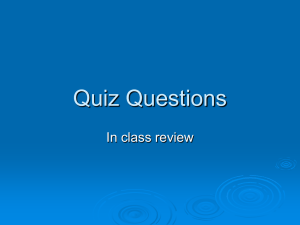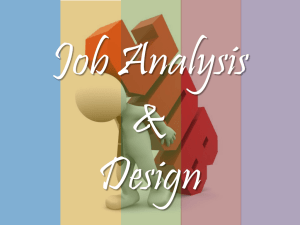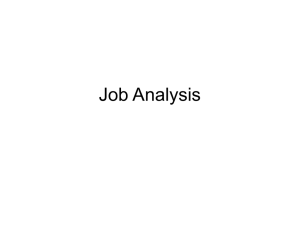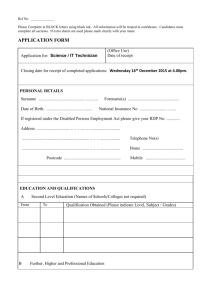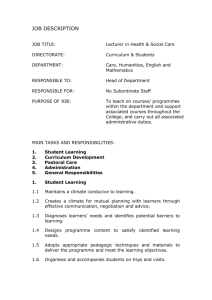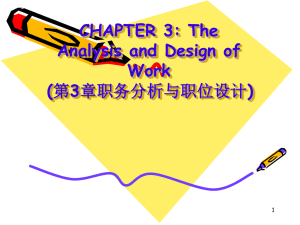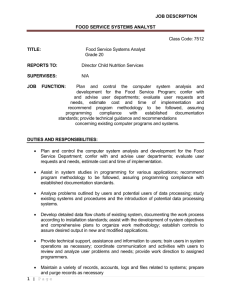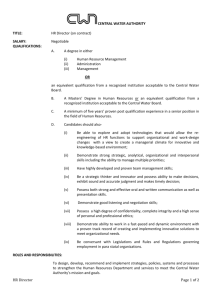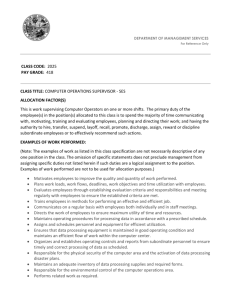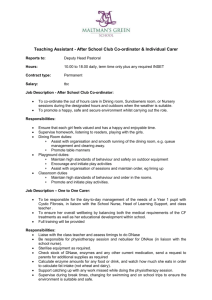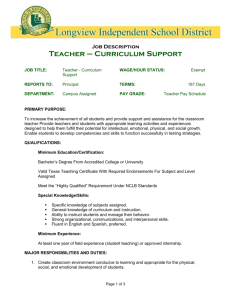Job Analysis & Design: Public Personnel Admin Lecture
advertisement
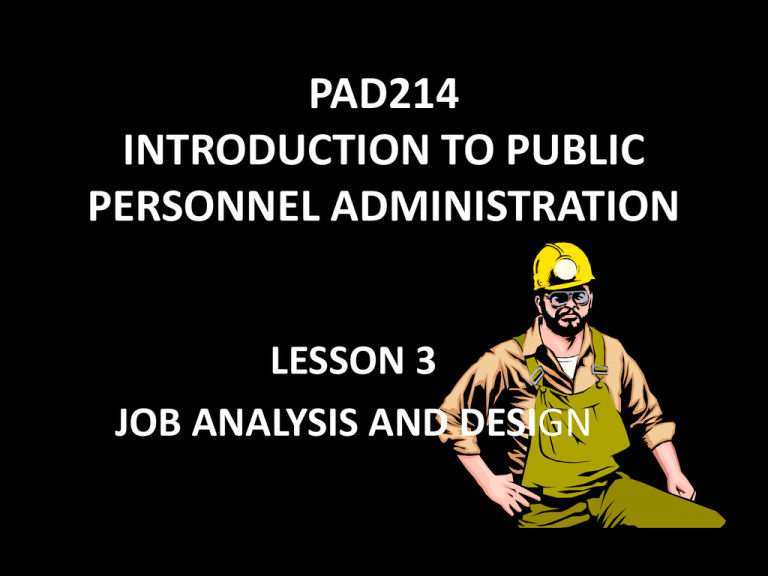
PAD214 INTRODUCTION TO PUBLIC PERSONNEL ADMINISTRATION LESSON 3 JOB ANALYSIS AND DESIGN SCOPE OF THE LECTURE One of the major concern of personnel management is employees performance. Generally, the level of employees performance depends on the pattern of specific job that assigned to them. Personnel management should conduct job analysis on every job to ensure that employee perform well and contributes to high level of productivity. This lecture explains the principles of job analysis and design in organization. OBJECTIVES OF THIS LECTURE Upon completing this chapter student should be able to: • Define the concept of Job Analysis and Design • Describe the uses and importance of JA • Describe the outcomes of JA • Identify the process / steps of JA • Describe the methods of JA • Describe Job design and the characteristics WHAT IS JOB ANALYSIS (JA) • Job analysis is a purposeful and systematic process for collecting information on the pattern of a job to determine tasks, duties and responsibilities needed and to determine on the importance of work related aspect of the job. • Job Analysis is a process to identify and determine in detail the particular job duties and requirements and the relative importance of these duties for a given job. Job Analysis is a process where judgments are made about data collected on a job. The principles of Job Analysis (JA) • JA reviewing the job responsibilities of current employees, • JA analyzing the work duties, tasks, and responsibilities that need to be accomplished by the employee filling the position, • JA researching and sharing with other companies that have similar jobs, and • JA articulation of the most important outcomes or contributions needed from the position. THE USES AND IMPORTANCE OF JA • • • • The data and output of job analysis providing the basis for conducting personnel management activities such as: Staffing – recruiting and selecting employees. Staffing would be haphazard if the recruiter did not know the qualification needed to perform the jobs. Training and development – job specification information often proves beneficial in identifying training needs. Compensation and rewards – determining pay rates for jobs, ensuring equal pay for equal work. Job and organisational design – designing job to improve efficiency or motivation. THE OUTCOMES OF JA • Job description - a written summary that explain about the duties , working condition , equipment used and other aspects of a specified job in which the job is performed. • Job specification – a written explanation of a minimum acceptable human qualities such as academic qualification , level of knowledge , skills , abilities, traits, and other characteristics necessary for effective performance on a job. THE CORE INFORMATION OF JOB DESCRIPTION • Job title – title of the job and other identifying such as its wage and benefits classification • Job responsibilities – describe the purpose of the job and what outputs are expected from job incumbents • Job requirements – clear statements of the tools, equipment , and information required for effectively performing the job • Job environment – description of the working conditions of the job, location of the job. THE CORE INFORMATION OF JOB SPECIFICATION • Requisite knowledge, skills, attitude and personal attributes. • Specific qualification of job • Previous experience • Age • Health • Special condition THE PROCESS/STEPS OF JA • • • • • • • • Identify the purpose of job analysis Selecting the analysts Selecting the appropriate methods Train the analysts Preparation of job analysis Collecting data on job activities Review and verify the information Develop job description and specification THE METHODS OF CONDUCTING JA • Direct observation – analyst observed actual work in progress and makes notes as necessary under the various heading of the job description. • Interview – face to face conversation with the job holder, their immediate managers and others who can give useful knowledge. • Questionnaire – the job analyst compiles a series of question design to elicit the maximum possible useful information about the job under analysis, and distributes this with careful instructions about the completion of the form. • Diaries – the job analyst provide job holder with the areas of the job description about which information is required. Job holders then analyse their own work over period of time, recordings information systematically in diary from Clog book under the required headings and the time spent on each item. • Competency Profiling - is the activity of determining the specific competencies that are characteristic of high performance and success in a given job. http://www.google.com.my/search?sourceid=navclient&aq=2h&oq=HUMAN+ &ie=UTF-8&rlz=1T4GGLL_enMY383MY384&q=human+resource+planning JOB DESIGN • Job design is a process of determining the specific tasks to be performed, the methods used in performing these tasks, and how the job relates to other work in the organisation. • In organizational development (OD), work design is the application of Socio-Technical Systems principles and techniques to the humanization of work. • Work arrangement (or rearrangement) aimed at reducing or overcoming job dissatisfaction and employee alienation arising from repetitive and mechanistic tasks. • The aims of work design to improved job satisfaction, to improved through-put, to improved quality and to reduced employee problems, e.g., grievances, absenteeism. • Through job design, organizations try to raise productivity levels by offering non-monetary rewards such as greater satisfaction. The elements of job design What tasks? Where to locate? What sequence? Who else? How to interface with the facilities? What skills? How much autonomy? What environmental conditions? METHODS OF JOB DESIGN • Job enrichment/enhancement – consist of basic changes in the content and level of responsibility of a job so as to provide greater challenge to the worker. It is a vertical restructuring method in that it gives the employee additional authority, autonomy, and control over the way the job is accomplishment. Job enrichment is an attempt to motivate employees by giving them the opportunity to use the range of their abilities • Job enlargement – involves changes in the scope of a job to provide greater variety to the worker. It provides a horizontal expansion of duties. Job enlargement may also result in greater workforce flexibility. TUTORIAL • Define Job Analysis • Describe the objective and purpose of JA in an organisation • Describe the outcomes of JA • Explain the steps can be taken by the management to conduct JA • Describe the methods of conducting job analysis. • Describe job design and methods of conducting job design. THAT ALL FOR TODAY SEE YOU AGAIN NEXT LECTURE LESSON 4 RECRUITMENT

